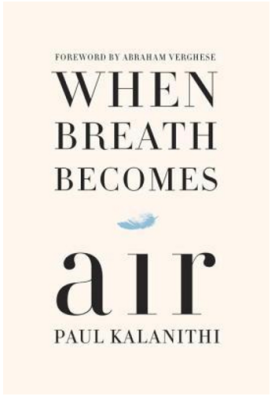When Breath Becomes Air – Paul Kalanithi

To read this book is to spend precious time with 36 year old neurosurgeon Paul Kalanithi as he wrote of his life in the last months of it. His wife Lucy write in the Epilogue: “This was the life he was given and this is what he made of it. When Breath Becomes Air is complete just as it is.”
Paul had an undergraduate and graduate degree in English Literature which is reflected in the beautiful prose of his memoir. He masters the art of the compelling turn of phrase, rendering concepts so beautifully and so memorably.
In considering a choice of summer jobs in college between a primate lab and working at a summer camp, he ponders: “If the unexamined life was not worth living, was the unlived life worth examining?” He was clearly a deep thinker all of his life.
His choice to go into medicine was a surprise that came to him in graduate school, despite the fact that both his father and brother are physicians. In retrospect, his choice of neurosurgery was a perfect marriage of his life of the mind with the biology of the mind. It was something that evolved through his graduate studies and final thesis.
Paul came to understand deeply the implications of his work as a neurosurgeon. “People often ask if it is a calling, and my answer is always yes. You can’t see it as a job, because if it’s a job, it’s one of the worst jobs there is.”
He came to see that “The call to protect life—and not merely life but another’s identity; it is perhaps not too much to say another’s soul—was obvious in its sacredness. Before operating on a patient’s brain, I realized, I must first understand his mind: his identity, his values, what makes his life worth living, and what devastation makes it reasonable to let that life end.”
His love of language made me stop and re-read many passages and to wonder at his ability to capture a concept.
“When there is no place for the scalpel, words are the surgeon’s only tool.”
“A tureen of tragedy was best allotted by the spoonful. Only a few patients demanded the whole at once. Most needed time to digest.”
“In these moments I acted not, as I most often did, as death’s enemy, but as its ambassador.”
His years of striving at Stanford, at Yale Medical School and through years of residency was a journey he shares in these pages. He talks about Shep Nuland, the author of How We Die, whom he describes as a “surgeon philosopher” and who still lectured at Yale then, as someone who “so directly and wholly addressed that fundamental fact of existence: all organisms, whether goldfish or grandchild, die.”
As he works his way through grueling years as a neurosurgical resident, he comes to a deep understanding about his role in other people’s lives. “Technical excellence was not enough. As a resident, my highest ideal was not saving lives – everyone dies eventually – but guiding a patient or family to an understanding of death or illness.”
Paul also weaves his religious beliefs into his life’s narrative, not always in a direct or obvious way, but as metaphor. “Openness to human relationality does not mean revealing grand truths from the apse; it means meeting patients where they are, in the narthex or nave, and bringing them as far as you can.”
Despite his daily interaction with questions of life and death, he wasn’t prepared for a terminal diagnosis at 36. “Severe illness wasn’t life-altering, it was life-shattering. It felt less like an epiphany—a piercing burst of light, illuminating What Really Matters—and more like someone had just firebombed the path forward.” He felt he traversed the five stages of grief, but had done it backward. He concluded, “Death may be a one time event, but living with a terminal illness is a process.”
He came to understand so much as he experienced his life as a patient instead of a surgeon. “The physician’s duty is not to stave off death or return patients to their old lives, but to take into our arms a patient and family whose lives have disintegrated and work until they can stand back up and face, and make sense of, their own existence. My own hubris as a surgeon stood naked to me now.”
Paul and his wife Lucy made the decision to have a child after his diagnosis. His daughter was born on the 4th of July and was 8 months old when he died. The Epilogue to this book written by his wife Lucy is poignant and instructive on its own. “Bereavement is not the truncation of married love,” C. S. Lewis wrote, “but one of its regular phases—like the honeymoon. What we want is to live our marriage faithfully through that phase too.” And Lucy continues to be comforted by feeling that Paul is with her still.
Like so many others who have found the gifts in an extended illness, Lucy concludes, “He let himself be open and vulnerable, let himself be comforted. Even while terminally ill, Paul was fully alive; despite physical collapse, he remained vigorous, open, full of hope not for an unlikely cure, but for days full of purpose and meaning.”
This book is full of Paul Kalanithi’s deepest thoughts on the purpose and the meaning of his life – so beautifully written and generously shared with all of us who will walk this same path to the termination of our lives. It’s not about the end, it’s about the search for purpose in meaning in the path we choose to take.